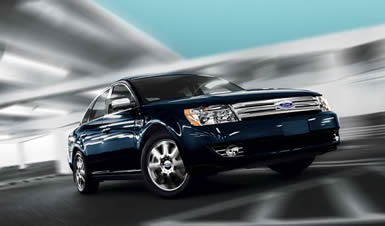|

New Car Review:
The Taurus, once the shining gem in Fordís crown, was quietly put out to
pasture a couple of years ago. Ford brought in the Five Hundred in its
place.
The Five Hundred itself
was not a bad car. Ford made it taller, a little like an SUV, for that
command of the road feel. They also went stark conservative in the
styling department. Whether this was because of the shared Volvo
platform or the nightmare of the all-ovals 1996 Taurus is uncertain.
In a surprisingly
candid moment in mid 2007, Ford management announced the rebadging of
the Five Hundred as a Taurus, which is what it was likely destined to be
called in the first place. The marketing folks believed that a familiar
name would help sell more cars.
The verdict? So far,
sales have not changed with the new name, but the car is, luckily,
heavily revised, with more than 500 improvements - some substantial.
More significant than
simply attaching the Ford three-bar chrome grille to the nose and
tweaking the hood and taillamps, Ford upgraded engine power. They
replaced the Five Hundredís anemic 3.0-liter V6 with the 3.5 liter
Duratec, which boosts horsepower to 263, up nearly 30 percent. You
really feel the welcome difference out on the road. The Duratec engine
is not the quietest in the industry, but through its six-speed automatic
transmission it is smooth and effective.
The Taurus is available
with front-wheel drive or optional all-wheel drive. All- wheel drive
enhances safety when driving conditions deteriorate because of rain,
snow, or gravel. Combined with the AdvanceTrac electronic stability
control system, the Taurus earns bragging rights as the safest large car
in America. It nailed all four of the U.S. governmentís crash tests with
a report card full of five-star ratings.
Despite the bigger
engine, the new Taurus beats the previous Five Hundred in fuel economy,
now rated at 17 City, 24 Highway with all-wheel drive, 18 and 28 with
front-wheel drive. I averaged about 16.5 mpg in mixed driving. The EPA
Green Vehicle numbers are a remarkably clean 9.5 for the Air Pollution
Score and a middling 5 or 6 for the Greenhouse Gas score. The 6 rating
is for the front-wheel-drive version.
Nothing does more to
make a car feel cheap than noise, and the new Taurus has obliterated it.
This was no simple process. They added various kinds of insulation,
including a high-tech substance called Sonosorb, in places like the
doors, headliner, and window pillars. They made the air conditioning run
more quietly. They revised the way the engine and transmission are
attached to the body and used hydraulic mounts to minimize transferred
vibration.
This change of engine
mounting allowed the engineers to tweak the suspension. They increased
front suspension travel by 10 percent, added new dampers and springs
front and rear, and retuned the rear suspension. The result is a quiet,
yet firm ride.
Stepping inside, youíll
appreciate the attempts at making the Taurus read upscale. Besides a
refreshingly careful fit and finish, the dash and armrests wear some
very real-looking woodgraining. The gauges are especially attractive.
The dash itself is a geometry lesson, mixing circles for the major
gauges, trapezoids for the minor ones, an oval clock, and rectangular
air vents. Despite this fascinating mixture of shapes and textures, it
all works fine in daily driving.
The Taurus is a large
car, weighing just under two tons with all-wheel-drive, but doesnít
really manifest that way when you walk up to it. The greater height
makes it easy to slide in without bending your knees and headroom is
airy. Maybe the customers for the ancient Crown Victoria will finally
move on to something modern.
Speaking of modern,
what could be more up-to-date than the Microsoft Sync program? Sync
enables voice-activated, hands-free control of the audio system and
communications. Just plug in your iPod or use Bluetooth with your cell
phone and youíre connected. You can only get this new technology in Ford
products, at least for now.
Built in Chicago, the
all-American Taurus comes only as a sedan, in SEL and Limited trims. My
Alloy Clearcoat Metallic (gray) tester was a Limited and featured a
handsome black leather interior. It also included several options,
including the Limited Convenience Package ($475) with a garage door
opener, cargo net, adjustable pedals (with memory) and, most important,
the reverse sensing system (should be standard in all cars). Throw in a
power moonroof ($895), navigation system ($1,995), Sirius satellite
radio ($195), and destination charges and youíre looking at a sticker
price of $33,500. Wow! You can pick up a well-equipped SEL with nothing
extra for $24,000.
The 2008 reborn Taurus
is a worthy successor to the car that had Ford sitting pretty in the
1980s. With its remarkably clean engine, itís a responsible choice as
well, if you need a roomy sedan.
By Steve Schaefer ©
AutoWire.Net - San Francisco

Ford Home Page
Byline: New Car Review provided by Tony
Leopardo © AutoWire.Net
Column Name: The all-American Taurus is
back!
Topic: The 2008 Ford Taurus
Word Count: 874
Photo Caption: The 2008 Ford Taurus
Photo Credits: Ford Taurus Internet Media
Series #: 2008 - 22
Download
the Microsoft Word version here:
2008 Ford Taurus
Download the Original Image File here:
2008 Ford Taurus


|
